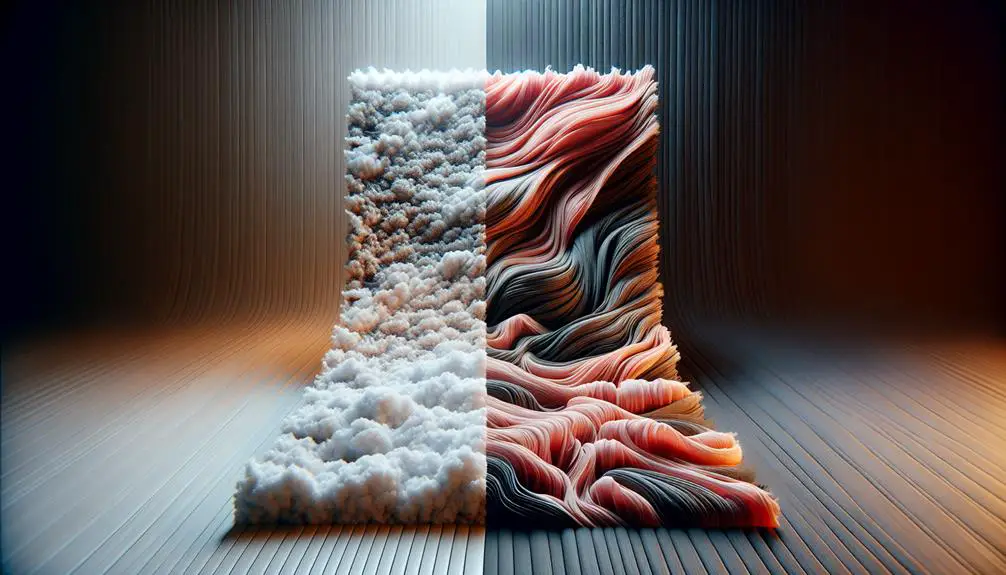As I ran my fingers across the soft cotton shirt and then the smooth polyester one, the differences became apparent. Despite their similar appearance, these fabrics hold distinct characteristics that go beyond touch.
We'll uncover how each fabric influences not just our clothing choices but also the environmental impact and performance expectations. Let's explore the realms of comfort, sustainability, and durability in the world of textiles.
Table of Contents
Key Takeaways
- Cotton is soft, breathable, and biodegradable, while polyester is durable and resistant to wrinkles.
- Cotton is environmentally friendly and sustainable, unlike polyester derived from petroleum.
- Cotton requires delicate care but is gentle on skin, while polyester is ideal for high-wear items.
- Making informed choices between cotton and polyester is crucial for sustainability and comfort.
Cotton Processing
Cotton processing involves transforming raw cotton fibers into a refined material through a series of purification steps that enhance its natural properties. Cotton fibers are unique as they're composed of pure cellulose, making them entirely natural and biodegradable.
Initially, cotton fibers are naturally hydrophobic due to the waxes coating them. However, during the processing stages, these fibers undergo a purification process that removes oils and waxes, making cotton more absorbent. This process is crucial as it enhances the cotton's ability to absorb moisture, making it more comfortable to wear.
Additionally, the purification steps contribute to improving cotton's breathability and hypoallergenic properties, making it a preferred choice for those with sensitive skin. By stripping away impurities, cotton processing ensures that the end product isn't only refined but also optimized for comfort and performance.
Cotton Properties
I'm excited to share the unique characteristics of cotton that set it apart from polyester.
Let's explore how the fabric feel of cotton differs from polyester.
Why cotton's absorbency levels are noteworthy.
And the environmental impact considerations when choosing between the two materials.
Let's dive into the world of cotton properties!
Fabric Feel Differences
Feeling like a gentle hug on your skin, cotton fabric offers a soft and luxurious touch that keeps you comfortable all day long. The natural fibers of cotton create a fabric that feels exceptionally soft and pleasant against the skin, making it a popular choice for clothing and bedding.
Cotton's breathability allows air to flow through the fabric, making it perfect for warmer days. Additionally, cotton has a natural moisture-wicking property, with a moisture regain of 8.5%, ensuring you stay dry and comfortable. Its hypoallergenic nature is gentle on sensitive skin, reducing the risk of irritation.
The smooth texture of cotton adds to its luxurious feel, providing a delightful sensation with every touch.
Absorbency Levels Comparison
With an impressive natural moisture regain of 8.5%, cotton stands out for its exceptional absorbency levels, making it a favored choice for breathable and comfortable textiles.
- Cotton's natural moisture regain of 8.5% enhances its absorbency.
- The purification process of cotton removes oils and waxes, further boosting its absorbency.
- Despite being naturally hydrophobic, cotton fibers become highly absorbent after processing.
- The collapse of lumens in cotton fibers when dried contributes to their absorbent nature.
Cotton's absorbency levels play a significant role in its popularity for creating textiles that aren't only comfortable but also allow for breathability. These properties make cotton a preferred choice over polyester when absorbency is a key consideration in textile selection.
Environmental Impact Considerations
Cotton's absorbency not only impacts comfort but also plays a crucial role in its environmental friendliness, making it a standout choice in sustainable textile production. By embracing organic farming methods, cotton can be grown sustainably, reducing the need for harmful pesticides. In contrast, conventional cotton farming ranks high in pesticide use among crops.
Additionally, cotton's biodegradability stands out as it naturally breaks down over time, minimizing environmental waste. In comparison, polyester, a synthetic material, takes hundreds of years to decompose, posing significant challenges for the environment. Exploring plant-based polyester options could offer a more eco-friendly solution, reducing pollution and promoting sustainability in the textile industry.
The choice between cotton and polyester can significantly impact our environmental footprint, making informed decisions crucial for a more sustainable future.
What Is Polyester Made Of?
Polyester, the versatile synthetic fabric, is crafted through a chemical reaction involving purified terephthalic acid (PTA) and monotheluene glycol (MEG), both derived from petroleum-based sources like petroleum and natural gas.
- Polyester fibers are solid polymers with no void spaces inside, making them durable.
- The production process of polyester involves high temperatures and pressing the viscous mass through small holes.
- It's made from petroleum-based products, such as petroleum and natural gas.
- Recycled polyester can be made from PET bottles and packaging, offering a sustainable option.
Understanding that polyester is essentially a result of a chemical fusion between PTA and MEG, both originating from petroleum-based sources, sheds light on its synthetic nature. The resilience of polyester fibers, the intricate production process involving high temperatures, and the possibility of transforming PET waste into recycled polyester showcase the innovation and sustainability potential within the polyester industry.
Polyester Properties
Polyester has some intriguing properties worth exploring. From its ability to repel water to its lower moisture-wicking capabilities compared to cotton, there's a lot to consider when it comes to this synthetic fiber.
Its strength, durability, and resistance make it a popular choice for various applications.
Polyester Durability
With its higher tensile strength and resistance to stretching and shrinking, polyester stands out for its remarkable durability in various applications.
- Polyester's durability comes from its strong molecular composition.
- The higher tensile strength of polyester makes it less likely to stretch out of shape.
- Polyester's resistance to abrasion ensures it withstands wear and tear better than cotton.
- The fibers of polyester are less prone to fraying, contributing to their long-lasting quality.
Polyester's ability to maintain its shape, resist stretching and shrinking, and withstand abrasion sets it apart as a durable choice for a wide range of uses.
Polyester Moisture-wicking
Moisture-wicking properties are a key feature that sets polyester apart from cotton in the realm of fabric performance. Polyester, being hydrophobic, repels moisture rather than absorbing it like natural fibers such as cotton. This hydrophobic nature allows polyester to be designed specifically for moisture-wicking purposes, making it ideal for activewear and outdoor clothing where managing moisture is essential. Unlike cotton, which tends to retain moisture, polyester moves sweat away from the skin, keeping the wearer dry and comfortable. The table below summarizes the differences in moisture-wicking properties between polyester and cotton:
| Property | Polyester | Cotton |
|---|---|---|
| Moisture Absorption | Low | High |
| Wicking Ability | Moderate to High | Low |
| Hydrophobicity | Yes | No |
Cotton Vs. Polyester
Often overlooked in the realm of fabric choices, the debate between cotton and polyester is a crucial one that impacts our daily lives in more ways than we realize. When considering cotton vs. polyester, it's essential to understand the differences between these two materials:
- Natural vs. Synthetic: Cotton is a natural fiber, while polyester is a synthetic fiber derived from petroleum-based chemicals.
- Breathability: Cotton is breathable, absorbent, and hypoallergenic, making it ideal for sensitive skin and hot climates.
- Durability: Polyester is stronger and more stretchable than cotton, making it more durable in various applications.
- Environmental Impact: Cotton is sustainable and biodegradable, whereas polyester isn't eco-friendly as it's derived from petroleum products.
Environmental Impact
The environmental impact of fabric choices, particularly between cotton and polyester, is a critical aspect to consider in today's world of sustainability and eco-conscious living. Cotton, being biodegradable, stands out as a more eco-friendly option compared to polyester, which takes hundreds of years to degrade.
However, the downside of conventional cotton lies in its heavy use of pesticides, causing harm to the environment. On the other hand, polyester production poses environmental threats at every stage, from extraction to manufacturing processes. A potential solution lies in plant-based polyester, offering a more sustainable choice that can help reduce pollution caused by traditional petroleum-based polyester.
Durability and Care
When considering fabric choices, durability and care play a crucial role in determining the longevity and maintenance ease of the material. Polyester stands out as a more durable option compared to cotton due to its higher fiber strength, ranging from 2.5 to 9.5 grams/denier.
Here are some key points to consider regarding the durability and care of polyester and cotton:
- Polyester's Strength: Polyester maintains its strength in various conditions, making it a reliable choice for long-term use.
- Shrinking and Wrinkling: Polyester is more resistant to wrinkles and shrinking, simplifying maintenance routines.
- Cotton's Maintenance: Cotton requires more delicate care to prevent shrinking and wrinkling, demanding more attention than polyester.
- Longevity: The durability of polyester makes it ideal for items subjected to frequent washing and wear, ensuring lasting performance over time.
Comfort and Breathability
Moving from considerations of durability and care, let's now explore the topic of comfort and breathability when comparing cotton and polyester fabrics. When it comes to comfort, cotton takes the lead. Its natural fibers are soft against the skin, providing a cozy and breathable feel. On the other hand, polyester, being synthetic, is less breathable and can cause discomfort, especially in hot and humid conditions. For those with sensitive skin, cotton is often the preferred choice due to its gentle touch and air circulation properties. To highlight the differences more clearly, let's take a look at the table below:
| Aspect | Cotton | Polyester |
|---|---|---|
| Comfort | Soft, comfortable, and gentle on skin | Can feel less comfortable |
| Breathability | Allows air circulation | Tends to trap heat and moisture |
| Skin Sensitivity | Ideal for sensitive skin | May cause irritation for some |
In essence, if comfort and breathability are your top priorities, cotton is likely to be the better option, especially for those with sensitive skin.
Suitability for Different Uses
In considering the suitability of cotton and polyester for different uses, it becomes evident that each fabric offers distinct advantages based on their unique properties and characteristics. Cotton is often preferred for clothing, bedding, and towels due to its softness, breathability, and absorbency. On the other hand, polyester shines in outdoor gear, jackets, and scarves because of its durability, wrinkle resistance, and quick drying properties.
Here are some key points to highlight the suitability of each fabric:
- Cotton:
- Ideal for clothing, bedding, and towels.
- Known for its softness and breathability.
- Offers great absorbency, making it perfect for towels.
- Commonly used in socks, denim, and flannel fabrics.
- Polyester:
- Suitable for outdoor gear, jackets, and scarves.
- Highly durable and wrinkle-resistant.
- Quick drying properties make it ideal for outdoor activities.
- Popular choice for insulation and fleece in cold weather.
Blending cotton and polyester can combine the advantages of both fibers, making them versatile for activewear and home textiles.
Frequently Asked Questions
Which Is Better Cotton or Polyester?
I prefer cotton for its breathability, absorbency, and gentle feel on my skin. Polyester, on the other hand, is my go-to for durability, wrinkle resistance, and vibrant colors. The choice between them depends on specific needs and preferences.
Is Cotton or Polyester Better for Summer?
In summer, I'd choose cotton over polyester any day. Cotton's breathability and moisture-wicking properties keep me cool and dry. Plus, did you know cotton can absorb up to 27 times its weight in water? That's impressive!
Does Polyester Feel Like Cotton?
Polyester doesn't feel like cotton; it's smoother and synthetic. Cotton's softness and comfort outshine polyester. Polyester can seem slippery and less breathable. Cotton's natural texture differs from polyester's slickness. The tactile experience varies between the two.
Is 100% Cotton Better Than Cotton Polyester Blend?
I believe 100% cotton is better than a cotton-polyester blend for hot weather due to its breathability. However, for durability and wrinkle resistance, I'd lean towards the blend. The choice depends on comfort, durability, and maintenance preferences.
- Recycling Nonwoven Fabrics: Is It Possible? - July 11, 2025
- Recycling Nonwoven Fabrics: Is It Possible? - July 11, 2025
- Recycling Nonwoven Fabrics: Is It Possible? - July 11, 2025




